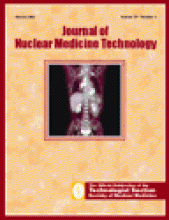G.T. Krishnamurthy, S. Krishnamurthy. Berlin Heidleberg, Germany: Springer-Verlag; 2000; 330 pages; $169.00, hardcover; ISBN 3-540-65917-X.
Nuclear Hepatology is a textbook written for medical practitioners who care for patients with hepatobiliary diseases. With almost 300 pages, 152 figures, 246 Illustrations and 72 tables, it proves to be a reference book as well as a procedural guide for hepatobiliary diseases. Due to plentiful comparisons with other diagnostic imaging methods, the reader learns about the value of hepatobiliary imaging with radiopharmaceuticals. The authors elaborate on diagnostic imaging procedures that are clinically well-established, plus those that are expected to earn importance in the near future. Emphasis is also placed on the evaluation of transplant-related complications.
Chapter 1 pertains to anatomy, including embryology and histology, and Chapter 2 discusses the physiology of the hepatobiliary system. Both chapters provide sufficient detail to understand the image interpretations in subsequent chapters. Although Chapter 3 describes pharmacokinetics and clinical application of both morphology and physiology imaging agents, the authors discuss physiology imaging agents in much greater detail. That is because liver imaging agents either detect pathology by showing changes in liver morphology, or identify changes in liver physiology. Radiocolloids are the most common radiopharmaceuticals for imaging morphology, and 99mTc-HIDA compounds are the preferred agents for physiology. Since liver morphology imaging is performed mostly via CT or ultrasound, imaging of physiologic and pathophysiologic conditions is currently the most common diagnostic procedure in nuclear hepatology. The authors considered these factors when writing Chapter 3.
Chapter 4 describes imaging of the liver and spleen morphology by radiocolloids. It supplies us with most of the morphology changes and the diseases that could be responsible for these changes. The wide variations in the shape of a normal liver also are illustrated in this chapter. Relative merits of the different diagnostic tests are compared. While positive and negative predictive values and sensitivities of the different diagnostic tests are similar, radiocolloid scans have been almost replaced by CT and ultrasound. Deciding on 1 of these 3 imaging modalities depends on local expertise, availability, reproducibility, and cost. It is more reasonable to combine 1 morphologic and 1 physiologic imaging modality than 2 or more morphologic imaging procedures. This chapter stresses the fact that radiopharmaceutical imaging can compete with other diagnostic methods to detect morphology changes. It is worth mentioning that SPECT imaging using 99mTc-labelled red blood cells and MRI imaging show a similar sensitivity for the detection of hemangiomas above the size of 2 cm. Furthermore, the overall detectability of focal nodular hyperplasia with 99mTc-mebrofenin cholescintigraphy is higher than with CT or with MRI. The detection of somatostatin receptor positive tumors, like gastrinomas, with 111In-pentetreotide scintigraphy is 92%, compared with a sensitivity of 83% using multimodality imaging.
Data acquisition and methods of quantification of various physiologic parameters are explained in Chapter 5. Since physiologic changes usually precede morphologic alterations by several weeks or months, there is a great potential for early diagnosis through scintigraphy. The most common tracer for quantitative hepatobiliary functional imaging is 99mTc-HIDA. Measurement of radioactivity emitted from the liver serves as a direct indicator of the physiologic status of the hepatocyte, nearly unaffected by renal function. 99mTc-HIDA not only enables quantification of the function of hepatocytes, but also allows for differentiation between hepatic and biliary disease. Hepatic extraction fraction and excretion half-time are 2 of the functional parameters measured routinely in hepatobiliary imaging.
In Chapter 6, the reciprocal relationship between the function of the gallbladder and the sphincter of Oddi is examined. Moreover, the effect of hormones (cholecystokinin) and drugs (opioids) on them is discussed. It is very important for a referring practitioner that the imaging procedure shows whether a cholestasis is due to intrahepatic or extrahepatic pathology, since therapy strategies result from this localization. To emphasize the importance of the location, Chapter 7 describes the diagnostic parameters of intrahepatic cholestasis, while Chapter 8 covers the diagnostic parameters of extrahepatic cholestasis. The different hepatobiliary diseases causing either intrahepatic or extrahepatic cholestasis are explained thoroughly in both chapters. The changes in cholescintigraphy are explained systematically for each disease.
Diseases of the gallbladder are the topic of Chapter 9. Cholescintigraphy is used for measuring gallbladder motor function and for differentiating symptomatic from asymptomatic gallstones. Moreover, it shows morphologic changes as well as quantitative functional parameters. Cholescintigraphy using 99mTc-HIDA for detecting acute cholecystitis, for example, takes less than 90 minutes by administering morphine intravenously at 60 minutes, when the gallbladder is not seen. Since acute cholecystitis mainly manifests in cystic duct obstruction, and cholescintigraphy shows the status of the cystic duct, choleszintigraphic imaging is more reliable than ultrasound and CT, both of which depend on wall thickness as an indicator for acute cholecystitis.
Sphincter of Oddi spasm and cystic duct syndrome are the most common reasons for biliary dyskinesia. They both show an abnormal functional response to cholecystokinin, yet location is different. Chapter 10 deals with functional imaging for diagnosis of biliary dyskinesia.
Diagnosis of hepatobiliary diseases in newborns and children is reviewed in Chapter 11, and the final chapter addresses evaluation of liver function before and after transplantation.
In conclusion, the clear structure of this textbook allows it to be used as a procedural guide for hepatobiliary diseases as well as a reference book. The illustrations are of the highest quality and plentiful throughout the text. Most importantly, Drs. Gerbail T. and Shakuntala Krishnamurthy have combined their expertise to provide the medical community with a well-structured, sufficiently detailed textbook for nuclear diagnostic in hepatobiliary diseases.







